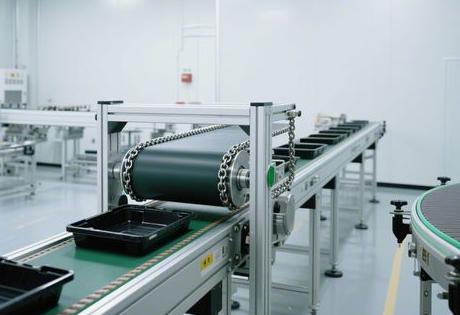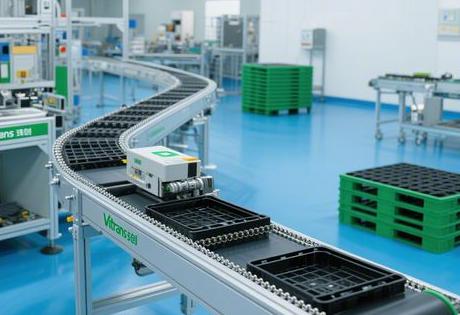I. Core Principle: Synergistic Evolution of Differential Speed and Space
The essence of the 2.5x double-layer multiplier chain is that thePrecision coupling of differential motion and stereospace multiplexing. The core mechanism is based on the roller (diameter D) and roller (diameter d) of theDiameter ratio (D/d ≈ 1.5)The speed of the pallet V= V₀×(1+D/d) is achieved by superimposing the movements. When the chain is running at 1.0 m/s, the actual speed of the pallet can be up to 2.5 m/s. This design derives a unique advantage in a two-tier architecture:

- spatial folding effect: The upper level conveys fully loaded workpieces and the lower level returns unloaded workpieces, the vertical cycle reduces the footprint by 40%, cracking the factory space dilemma;
- Gravitational potential energy reuse: 25° inclined angle return guide integrated flywheel energy storage system, recovering 30% downward kinetic energy to drive the jacking mechanism, reducing the overall energy consumption of 28%;
- Dynamic accumulation control: Hydraulic wedge blockers position the work plate with ±0.5mm accuracy, allowing specific stations to work independently without interrupting the full line flow.
personal insight2.5x speed is the golden mean of efficiency and stability - 3x speed leads to heavy load jerks, 2x speed is not efficient enough, and 2.5x speed is the optimal solution of friction loss and kinetic energy output.
II. Structural Analysis: Engineering Wisdom for Bilayer Topology
Double speed chain passes throughModular ArchitectureEnabling flexible adaptation:
vertical circulation system
- Shifter hubsServo motor-driven belt shifting mechanism achieves precise transfer of upper and lower workpiece boards in 0.3 seconds, with a synchronisation error of ≤0.1mm;
- Bias Load Resistant Design: Centrifugal compensating guideway built into the R=1.5m bend to counteract 0.5° inclination deviation due to 80kg load deflection.
Speciality material systems
- Composite Roller System: The inner layer of 42CrMo tempered steel (HRC58) is pressure-bearing, and the outer layer of polyurethane encapsulated rubber reduces noise, so that the noise under a 200kg load is ≤68dB;
- Bionic reinforcement of chain plates: Laser engraved fish scale pattern surface, stress concentration factor reduced by 35%, fatigue life exceeding 10⁷ cycles.
III. Growth rate mechanism: the physical code for 2.5 times the speed
At the heart of the effectiveness of the Speed Chain isRoller-roller synergistic dynamics::
plaintextmake a copy ofVelocity Breakdown: 1. base velocity V₀: linear velocity of the roller on the guideway (1.0 m/s) 2. additional velocity V₂: linear velocity of roller rotation (1.5 x V₀) 3. synthetic velocity V = V₀ + V₂ = 2.5V₀The key control points areFrictional Thermal Management--The expansion rate of engineering plastic roller needs to be stabilised below 0.08mm/100h after continuous operation, otherwise it leads to drift of speed ratio. A home appliance production line measurement shows: tungsten carbide coated roller so that the coefficient of friction μ ≤ 0.07, 8 hours of continuous operation speed ratio fluctuations <2%.
IV. Industry adaptation: from consumer electronics to heavy manufacturing
Consumer electronics assembly
- 750mm ergonomic height line body, with static dissipative roller (surface resistance 10⁶Ω), to ensure chip placement yield 99.98%;
- Modular expansion: additional visual inspection modules can be added to complete 120 pieces of product appearance quality inspection per minute.
Welding of automotive components
- The heavy duty version carries a 2000kg engine block and has an integrated 500A conductive slip ring for on-line power-on testing;
- Splatter-resistant design: Aluminium-zinc plating of the chain plate resists welding slag, increasing the life of the chain by up to 3 times.
Foodstuffs packaging workshop
- 316L stainless steel chain body + food grade grease, resistant to pH 2-12 detergent rinse;
- Intelligent beat control: automatically extend the stay by 0.8 seconds when the filling volume >500g.
V. Intelligent control: dynamic tuning driven by edge computing
Stability dependence of 2.5-fold chainsTertiary neural control网络::
plaintextmake a copy ofControl architecture: 1. Edge layer: strain gauge + RFID real-time monitoring of load distribution (response 1500kg) 3. Cloud platform: AI prejudge chain fatigue life, accuracy rate 91%A case study of a motor factory in Changzhou shows that the system has compressed the switching time of different types of tooling boards from 15 minutes to 110 seconds, while the breakdown and downtime rate has dropped by 73%.
VI. Future Evolution: Enabling Superconductivity and Quantum Sensing
Technological boundaries are being reconfigured by two types of breakthroughs:
Superconducting magnetic levitation guideway
- The YBCO coating achieves 98% potential energy recovery at -196°C in liquid nitrogen environment, and the return resistance approaches the theoretical zero point;
- In 2026 the Suzhou demonstration line will validate a single chain with 4000kg dynamic load.
quantum level sensing network
- MEMS gravity sensor compensates for 0.01-10Hz ground vibration, positioning accuracy jumps to ±0.03mm;
- Blockchain traceability system: each work plate generates a unique hash value, full life cycle data on the chain.
Exclusive foresightThe 2.5x chain will evolve into a "spatial topology deformer" - the liquid metal links support minute-level reconfiguration of the line form (tree/star topology), increasing the efficiency of line reconfiguration by 90%, ending the era of rigidity. production era.

Self-questioning: analysis of core issues
Q1: Why choose 2.5x speed instead of 3x speed?
A.Triple Effectiveness BalanceMake it so:
- stabilityJitter >1.5mm at 800kg+ load at 3x speed and 0.8mm at 2.5x speed.
- energy consumption ratio: High thermal power of 37% at 3x friction, additional cooling system required
- cost curve: 2.5x Speed Roller Life Extension over 3x Speed 40%
Q2: How does the double-layer structure solve the interference between the upper and lower layers?
A.spatio-temporal segmentation techniqueBreaking:
- Laser alignment systems: 16-point photoelectric barrier in the lift stroke of the lift, anti-collision response <0.1 sec.
- Staggered scheduling algorithm: Intersection time difference between upper fully loaded board and lower empty board ≥ 1.2 seconds
- Safe and redundant design: Hydraulic buffer absorbs 240J of impact kinetic energy
Q3: What indicators determine the success or failure of selection?
A.Gold parameter system::

- 0.5mm/100h expansion rate(Material weathering benchmarks)
- 2.5:1 speed ratio stability(Speed deviation ≤3% at load fluctuation ±20%)
- 8 seconds module reconfiguration time(standardisation of interfaces for minute-to-minute reconfiguration of production lines)
※ Technical parameters quoted from the IEEE White Paper on Intelligent Conveyor Systems (2025) and Mitsubishi Heavy Industries' production line test report.













